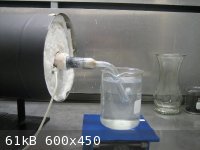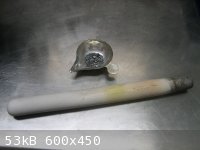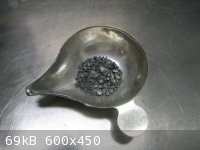Magpie
lab constructor
    
Posts: 5939
Registered: 1-11-2003
Location: USA
Member Is Offline
Mood: Chemistry: the subtle science.
|
|
pyrometallurgy
Preparation of Zn by the Reduction of ZnO
Yesterday I prepared Zn from pottery grade ZnO. The reaction vessel was a ceramic retort heated in a tube furnace to 1100C.
ZnO + C = Zn + CO
Procedure
10 grams of ZnO were mixed intimately with 5.9 grams of powdered coconut shell carbon. The amount of carbon is 4X that of stoichiometry to insure
that the formation of CO predominates over that of CO2.
The outlet of the retort was luted to a glass bent tube adapter with a 24/40 joint. The opening of the tailpipe was submerged 5cm to exclude oxygen
from the atmosphere. Just prior to heating, the retort/adapter assembly was backflushed with argon.
Results
The zinc deposited in a ridge of BB's about 5cm in from the end of the ceramic retort. It was scraped out with a knife. Yield was 5.4g; %yield was
67%.
Discussion
This is the results of Try #2. Try #1 was a failure, producing only ZnO smoke. Try #1 was not backflushed with argon and the tailpipe was left open
to the atmosphere.
Since the retort was kept level the Zn could not flow out the end. Also the end was too cold for it to remain a liquid. I could touch within 5cm of
the hot end of the glass adapter.
Improvements for Try#3 will be: (1) incline the furnace to an angle sufficient to get the liquid zinc to flow out as drops into the water, and (2)
provide heating of the glass adapter to a temperature above the mp of Zn using a heating jacket.
  
The single most important condition for a successful synthesis is good mixing - Nicodem
|
|
|
ammonium isocyanate
Hazard to Others
  
Posts: 124
Registered: 13-7-2009
Location: USA - Midwest
Member Is Offline
Mood: sick 
|
|
Probably not a good alternative to buying zinc at this point, but truly wonderful mad science!
I love it!
Pardon my ignorance, but I am unable to locate any detailed description/designs of your furnace, even with the SE. Could you please direct me to one,
or if one does not already exist, creat one (I imagine many members here would be grateful)?
|
|
|
Magpie
lab constructor
    
Posts: 5939
Registered: 1-11-2003
Location: USA
Member Is Offline
Mood: Chemistry: the subtle science.
|
|
Glad you like it.
http://www.sciencemadness.org/talk/viewthread.php?tid=9705#p...
The single most important condition for a successful synthesis is good mixing - Nicodem
|
|
|
User
Hazard to Others
  
Posts: 339
Registered: 7-11-2008
Location: Earth
Member Is Offline
Mood: Passionate
|
|
Pottery stores do sell more exotic metals.
I am not so creative at the moment but there could be some metals worth reducing.
Btw nice experiment, this is something out of my first chemistry book 
What a fine day for chemistry this is.
|
|
|
Picric-A
National Hazard
   
Posts: 796
Registered: 1-5-2008
Location: England
Member Is Offline
Mood: Fuming
|
|
Perhaps try melt the Zinc produced down to produce a mini ingot to remove the black layer
|
|
|
12AX7
Post Harlot
    
Posts: 4803
Registered: 8-3-2005
Location: oscillating
Member Is Offline
Mood: informative
|
|
Neet. Now distill commercial material for enhanced purity; fractionate cadmium if possible. 
Magnesium is another volatile metal; it may corrode your ceramics though.
Tim
|
|
|
Bikemaster
Hazard to Others
  
Posts: 120
Registered: 8-10-2008
Member Is Offline
Mood: No Mood
|
|
Ceramic! Magpie, did you have make an homemade test tube of ceramic. I know than garage chemist was working on this, but i never see results. If it is
the case, is it possible to know how you have made it?
And did you ever try the ceramic test tube to make any SO3 with it, and it yes did it resiste better that fuzed quarzt?
thanks
[Edited on 21-10-2009 by Bikemaster]
|
|
|
Magpie
lab constructor
    
Posts: 5939
Registered: 1-11-2003
Location: USA
Member Is Offline
Mood: Chemistry: the subtle science.
|
|
Yes, it's homemade and I am just following GC's lead, as usual. Learning how to make these retorts takes some time, which we have been doing in
parallel for at least 6 months. I was hoping that he would comment on my post as I have not heard from him for some time now. I'm a little hesitant
to talk fabrication details just yet as this is really GC's project. Please don't take this as being snobbish or stingy.
This was my first production run with the retort. I wouldn't jump into making something like SO3 without getting experience on something more benign.
My testing indicates a porosity of 2.5% and the wall thickness on this retort was 1.5mm. I will feel better about going for something like SO3 when
my wall thickness is at least 3mm and the porosity is very near 0%.
Edit: replaced "permeability" with "porosity"
[Edited on 21-10-2009 by Magpie]
The single most important condition for a successful synthesis is good mixing - Nicodem
|
|
|
Bikemaster
Hazard to Others
  
Posts: 120
Registered: 8-10-2008
Member Is Offline
Mood: No Mood
|
|
I'm really impress! and i will wait until GC really put his project on the forum.
As you said, SO3 is not a chemical to make the first experiences with...
Good luck with your research
|
|
|
merrlin
Hazard to Others
  
Posts: 110
Registered: 3-4-2009
Member Is Offline
Mood: No Mood
|
|
Quote: Originally posted by Magpie  | | My testing indicates a permeablity of 2.5% and the wall thickness on this retort was 1.5mm. I will feel better about going for something like SO3
when my wall thickness is at least 3mm and the permeability is very near 0%. |
Sintering high alumina bodies to full density can be difficult, particularly if there isn't a vitreous phase present. Maybe you could dip/spray coat
with an aluminum oxide sol (with perhaps a small amount of silica) to seal the surface. The small particle size of sols allows for higher sintering
densities at lower temperatures
|
|
|
watson.fawkes
International Hazard
    
Posts: 2793
Registered: 16-8-2008
Member Is Offline
Mood: No Mood
|
|
Quote: Originally posted by merrlin  | | Sintering high alumina bodies to full density can be difficult, particularly if there isn't a vitreous phase present. |
I've been reading up on mullite, and for that material they use MgO (IIRC) as a modifier of grain boundaries during sintering.
There's just enough low-melting eutectic with this addition to allow individuals grains to grow into each other at reasonable rate. There similar
grain modifiers used for alumina-only bodies. Again IIRC I've seen yttria used for this purpose. In both cases the percentages added are around 1% or
less.
|
|
|
Magpie
lab constructor
    
Posts: 5939
Registered: 1-11-2003
Location: USA
Member Is Offline
Mood: Chemistry: the subtle science.
|
|
Thank you for the suggestions.
We each have the capability to fire to cone 10 (1300C). I am using a mullite formulation with sufficient feldspathic added to reduce the porosity to
an acceptable level. Trying anything else would possibly entail another round of time consuming testing. Small additions, probably would not. Care
must be taken that the added flux is not at a high enough level to cause the retort to fuse to the funace ceramic tube, which in my case is made of
alumina. I already had this happen once. I had to knock it out with a hammer, leaving a small bump of ceramic fused to the furnace tube floor.
Every change makes a possible significant difference in the properties of the slip and the ceramic, green and fired.
The single most important condition for a successful synthesis is good mixing - Nicodem
|
|
|
watson.fawkes
International Hazard
    
Posts: 2793
Registered: 16-8-2008
Member Is Offline
Mood: No Mood
|
|
Quote: Originally posted by Magpie  | | Care must be taken that the added flux is not at a high enough level to cause the retort to fuse to the funace ceramic tube, which in my case is made
of alumina. I already had this happen once. |
Is it feasible to use an alumina lining powder to create a slip
layer between the furnace tube and the retort? This is mostly a question about the mechanical configuration you're using. I don't imagine that there's
a material problem.
|
|
|
Magpie
lab constructor
    
Posts: 5939
Registered: 1-11-2003
Location: USA
Member Is Offline
Mood: Chemistry: the subtle science.
|
|
| Quote: |
Is it feasible to use an alumina lining powder to create a slip layer between the furnace tube and the retort? This is mostly a question about the
mechanical configuration you're using. I don't imagine that there's a material problem.
|
Yes, this is quite feasible and would be good insurance. The ID of my furnace is 34mm whereas the OD of the retorts is 24mm. This would give plenty
of room for a thick kiln wash. This gap also gives plenty of room for insertion of the thermocouple.
The single most important condition for a successful synthesis is good mixing - Nicodem
|
|
|
garage chemist
chemical wizard
    
Posts: 1803
Registered: 16-8-2004
Location: Germany
Member Is Offline
Mood: No Mood
|
|
Very nice work Magpie.
I too have been working on ceramic retorts, and found a formula that will sinter gastight at 1280°C in 10 minutes, be resistant against thermal shock
and can be processed into thin-walled articles by slip casting.
It is
40% Kaolin
20% calcined alumina
40% potassium feldspar
made into a slip with water and a small amount of waterglass (Na silicate solution) so that the slip attains a density of 1,8g/ml or slightly higher.
I think this, or something similar, is what you used for your retort, Magpie, right?
I have not been able to solve the problem of tightly connecting the retort to a glass apparatus. This is absolutely neccesary when trying to make
air-sensitive products, such as phosphorus, potassium or even just zinc, as Mapie has shown.
First, I wanted to fuse a glass tube to the neck of the retort, but was told by the glassblower that this would be very unreliable and prone to
cracking.
Then I wanted to grind the retort neck to a 1:10 taper so that a NS14/23 fused quartz joint would fit in tightly. I did not get anywhere with this.
High precision is necessary for this, something notoriously difficult with ceramics.
The shrinkage and (slight, but noticeable) warping upon firing makes this a challenge.
From the glassblower, I even bought three metal cone grinding tools that are normally used to grind lengths of glass tube into standard taper joints.
I found that a precise preform is necessary to be able to use these tools to produce a joint that will actually fit a standard joint, something that I
could not do with the ceramic.
It is possible to "bisque fire" a piece to just 1000°C, where it becomes hard and machinable, but still highly porous, grind it into a preform and
then fire to 1280°C to produce the finished piece, and then do the final grinding. However, slight warping takes place, and the joint is not round.
I have made several ceramic tubes closed at one end, but not used them for anything yet.
Another formula,
40% Kaolin
60% alumina
becomes hard and durable at 1300°C (1h) and stays porous. The porosity is so fine that the outside slowly gets wet when water is filled in, but only
every 60 sec. or so does a drop of water fall off. This could potentially make an excellent diaphragm for electrolysis experiments due to its chemical
inertness.
Magpie, you seem to have used a lute that becomes viscous atoperating temperature to seal the retort to the apparatus.
I will have to try this as well.
I am concerned with removal of slag from the retort after the synthesis- ideally I want to be able to remove and re-attach the glass tube.
|
|
|
aonomus
Hazard to Others
  
Posts: 361
Registered: 18-10-2009
Location: Toronto, Canada
Member Is Offline
Mood: Refluxing
|
|
Regarding the warping issue you are having when trying to make ceramic ground joints, do you know what the equivalent to coefficient of expansion upon
firing is for ceramic relative to borosilicate glass? Perhaps uneven heating means that the firing doesn't happen evenly, what about a slower
temperature increase?
|
|
|
garage chemist
chemical wizard
    
Posts: 1803
Registered: 16-8-2004
Location: Germany
Member Is Offline
Mood: No Mood
|
|
No, it's not uneven heat doing the warping, it's gravity and the ceramic becoming plastic at maximum temperature.
Think of a horizontal glass tube on a flat surface being very slowly heated to its softening range- it slowly assumes an oval shape due to gravity.
Exactly this is what's happening with the ceramic.
Shorter, or cooler and longer firing does not fully densify the ceramic. A better formula could solve this problem, but I still consider the grinding
to be too much work.
Magpies method of simply using a lute is the best solution in my opinion.
EDIT: Ceramic generally has a much higher coefficient of expansion that glass. There are some exceptions, like glass ceramics and lithium-based
bodies.
[Edited on 22-10-2009 by garage chemist]
|
|
|
watson.fawkes
International Hazard
    
Posts: 2793
Registered: 16-8-2008
Member Is Offline
Mood: No Mood
|
|
Quote: Originally posted by garage chemist  |
[...] made into a slip with water and a small amount of waterglass (Na silicate solution) so that the slip attains a density of 1,8g/ml or slightly
higher. |
Have you tried deflocculants other than sodium silicate? How long did you stir the slip before
casting?
|
|
|
Magpie
lab constructor
    
Posts: 5939
Registered: 1-11-2003
Location: USA
Member Is Offline
Mood: Chemistry: the subtle science.
|
|
Thank you GC.
My ceramic formulation is similar to yours, but a little different:
39.1% kaolin
30.9% alumina
30.0% nepheline syenite (a feldspathic mineral)
The ratio of kaolin to alumina is stoichiometrically equivalent to the mineral mullite. With this formula I have seen no warping. I did get one
small spot weld of the retort to the alumina furnace tube out of about 4 firings on different retorts to 1300C.
I have found that the viscosity of the slip is critical. If it is too high it will pull a vacuum during drainout from the plaster mold. This will
collapse the closed end along several cm. My last retort (#15) was made using 67.2wt% solids. I assume a sp gr of 1.81 and calculate the amount of
material and water from that to make 250mL of slip. 1mL of 50% Na2SiO3 solution is added dropwise during let down of the slip to reduce viscosity. I
use a small Cowles agitator on a 5000 rpm drill press to get a good dispersion. Set time in the mold was 8 minutes and the resulting wall thickness
was 1/16" (~1.5mm). I need to increase the % solids to build this wall to 3mm. A little more sodium silicate solution will be used to keep the
viscosity down.
The model for the plaster mold was made with a 1.125" (29mm) wood dowel tapered on one end to 1:10. The taper was long enough that after shrinkage
due to firing (about 11%) part of the taper would be a 24/40 male. I tried to put the taper on with a belt sander but ended up hiring a carpenter
with a lathe, getting a much better product.
The fired retort tapered end is close to 24/40 but does not give a perfect fit with the glass female. It is a little less than 1:10. By sanding with
sandpaper (60 grit, then 100 grit) this fit is improved. This end then must be luted to the glass adapter.
The luting compound that I have been using is from US Patent 4192730:
0.24g rosin
0.20g molasses
1.56g fine carbon
4.5 mL water
Stir into a paste. The carbon I use is food grade activated carbon, an extremely fine powder.
The luting compound is crudely smeared onto the ceramic tapered end and the glass female end is twisted on.
During operation the water will evaporate away and the organics likely turn to carbon. During the production of Zn the preliminary ZnO smoke
backfilled in against the luting and made a very nice seal. Just how this luting may perform for other chemical species is up for speculation. It
may not be suitable.
The luting does not weld the pieces together - it's just finely powdered carbon. The glass piece is easily removeable and cleanable.
[Edited on 22-10-2009 by Magpie]
[Edited on 22-10-2009 by Magpie]
[Edited on 22-10-2009 by Magpie]
The single most important condition for a successful synthesis is good mixing - Nicodem
|
|
|
merrlin
Hazard to Others
  
Posts: 110
Registered: 3-4-2009
Member Is Offline
Mood: No Mood
|
|
Quote: Originally posted by garage chemist  |
I found that a precise preform is necessary to be able to use these tools to produce a joint that will actually fit a standard joint, something that I
could not do with the ceramic.
|
Have you considered using pyrophyllite? It is soft enough to scratch with a fingernail and is easily machined to close tolerances. After firing it is
quite hard and strong, although porous. During firing the aluminosilicate changes color from grey-blue to a pinkish hue. It also expands slightly. For
precision work (+/- a few mils) a reference piece can be measured, fired, and remeasured to determine the compensation that needs to be applied to
unfired part dimensions. It's thermal coefficient of expansion is fairly close to Pyrex borosilicate glass.
http://www.marylandlava.com/data.html
|
|
|
Texium
|
Thread Moved
19-11-2023 at 14:57 |